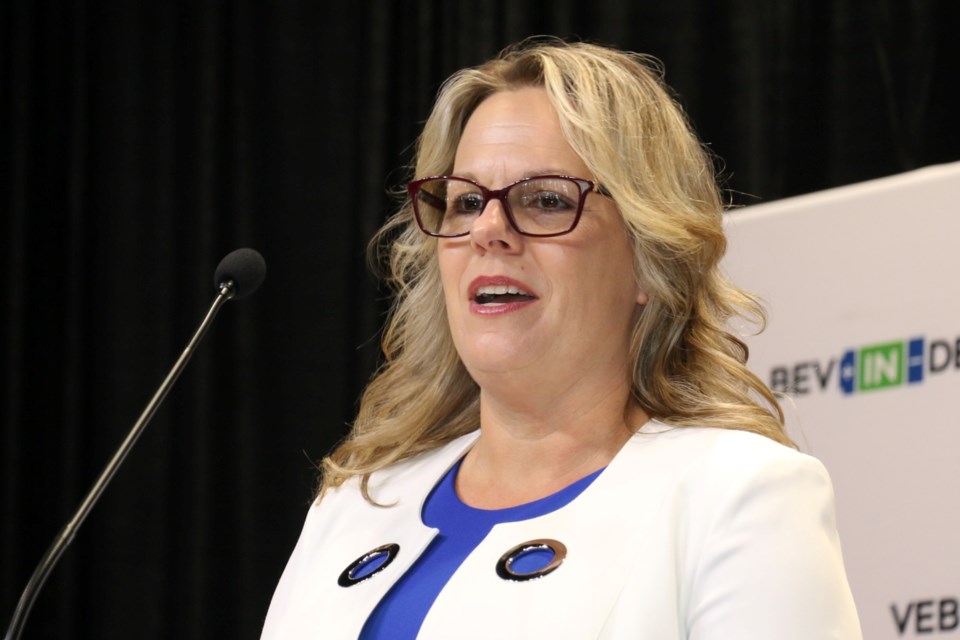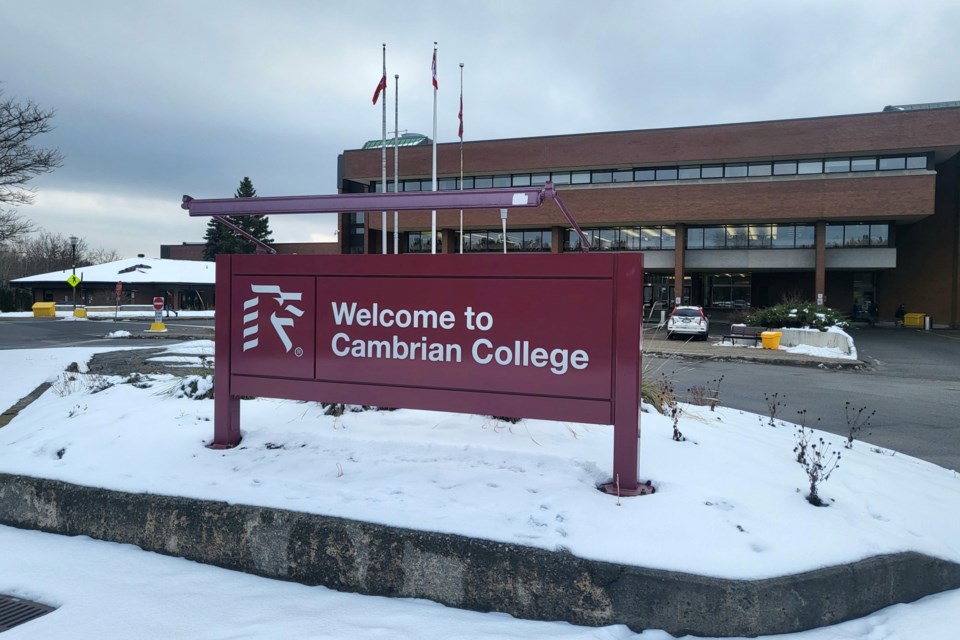Cambrian College’s international student population has seen rapid increases in recent years both on its Sudbury campus and at a private college offering programming in the Greater Toronto Area and Vancouver on Cambrian’s behalf.
In light of the recent federal announcement aimed at stemming the explosive growth of international students, Sudbury.com has taken a closer look at Cambrian College’s enrolment numbers, as well as the fiscal implications for the Sudbury college.
Cambrian College has the most skin in the game with regards to international students of the three Sudbury post-secondary institutions, although international enrolment at Laurentian University also increased substantially this school year.
Cambrian College’s on-campus international student enrolment in Sudbury has gone up by 204 per cent since 2018 and by 89 per cent in just the past 18 months.
The number of Cambrian College international students studying at the private college called Hanson Canada has increased by 212 per cent since 2018, including an 81 per cent increase in just the past 18 months.
There are currently 6,200 Cambrian international students studying at the Hanson Canada campuses.
The number of international students on Cambrian College’s Sudbury campus now actually slightly exceeds domestic students, with 3,200 international students studying in Sudbury, as well as just over 3,000 domestic students.
International students are seen as a ready source of cash for post-secondary institutions, as they pay higher tuition fees.
For example, the most expensive tuition paid by Cambrian international students is for its honours bachelor of nursing program, where the international tuition rate for the first semester is $11,809.47, plus $1,350 in ancillary fees. The tuition for domestic students in the same program is $3,172 in tuition, plus $726 in ancillary fees.
In January, the federal government announced it is making several changes to stem the explosive growth of international students being brought into Canada by post-secondary institutions, which has caused issues that include pressure on housing.
The federal government said it will set an intake cap on international student permit applications to stabilize new growth for a period of two years.
For 2024, the cap is expected to result in approximately 360,000 approved study permits, a decrease of 35 per cent from 2023.
Individual provincial and territorial caps have been established, weighted by population, meaning Ontario’s study permits will actually go down by about 50 per cent.
There are also several other measures in last month’s announcement surrounding the issuing of work permits for international students and their spouses.
Open work permits will soon only be available to spouses of international students in master’s and doctoral programs. The spouses of international students in other levels of study, including undergraduate and college programs, will no longer be eligible.
Starting in September, international students who begin a study program that is part of a curriculum licensing arrangement with a private college (such as Cambrian College's arrangement with Hanson Canada) will no longer be eligible for a post-graduation work permit upon graduation.
“These programs have seen significant growth in attracting international students in recent years, though they have less oversight than public colleges and they act as a loophole with regards to post-graduation work permit eligibility,” said the government announcement.
Federal Immigration Minister Marc Miller has called some of these private institutions "the diploma equivalent of puppy mills,” while Ontario Colleges and Universities Minister Jill Dunlop said some “bad actors” are taking advantage of these students.
Cambrian College president Kristine Morrissey, however, said in an interview with Sudbury.com last month that she believes the college is a “good actor” with regards to its Hanson Canada locations, and “we do believe in the education that the students are getting from Hanson Canada.”

Cambrian College’s international student enrolment: the numbers
We reached out to Cambrian College following the January federal announcement to request its international student enrolment figures from 2018 and on to get a better picture of its operations.
Hanson Canada delivers programming on behalf of Cambrian College in Toronto, Brampton and Vancouver, and has been in a partnership with Cambrian since 2005.
The international student enrolment figures provided by Cambrian for their Hanson campus are as follows:
- September 2018 - 1,981
- September 2019 - 2,106
- September 2020 - 3,215
- September 2021 - 2,989
- September 2022 - 3,421
- September 2023 - 6,021
- January 2024 - 6,200
Cambrian College also has international students who study here in Sudbury, on the college’s main campus. The enrolment numbers of these students have also increased markedly in recent years:
- September 2018 - 1,051
- September 2019 - 1,471
- September 2020 - 1,180
- September 2021 - 1,429
- September 2022 - 1,691
- September 2023 - 2,680
- January 2024 - 3,200
Enrolment figures show Cambrian College’s domestic student numbers have been faltering in recent years:
- September 2018 - 3,780
- September 2019 - 3,600
- September 2020 - 3,547
- September 2021 - 3,532
- September 2022 - 3,250
- September 2023 - 3,178
- January 2024 - A spokesperson for the college put this figure at “just over 3,000”
Some explanations from Cambrian
A written statement from the college accompanying the enrolment figures provided to Sudbury.com notes that during the early pandemic, its on-campus international student enrolment declined while its Hanson enrolment increased.
This was “due to the restrictions and conditions brought on by the COVID-19 pandemic,” the college said.
However, Hanson had the ability to recruit international students already living in the GTA and was less affected by travel restrictions and visa issues than Cambrian.
The college explains there had been a government-mandated ratio of 2:1 in place, meaning no more than two international students at the private college for every one student at the partner public college.
However, Cambrian slightly exceeded this ratio during the early pandemic, with the Ministry of Colleges and Universities acknowledging the challenges of the pandemic, “and did not express concern with the ratio.”
In 2023, the Ontario government scrapped the 2:1 ratio requirement and replaced it with an enrolment limit of no more than 7,500 students at the private college in partnership with a public college, Cambrian explained.
Although the enrolment figures show a rapid recent growth at Hanson, “we have intentionally not grown to the new cap to ensure that we are still able to support students appropriately,” said the college, in a statement to Sudbury.com.
The financial implications: $40 million per year
In writing this article, Sudbury.com requested an interview with Janneke Nicholls, Cambrian’s new vice-president of finance, administration and applied research, to drill down on some of the financial implications.
An interview with Nicholls was not granted, with Cambrian opting instead to provide written information.
As indicated above, we’d previously spoken to Cambrian College president Kristine Morrissey last month, in the days following the federal announcement.
Looking at Cambrian College’s audited financial statements for the financial year ending March 21, 2023, the college brought in $107 million in international student tuition fees in 2022-2023.
It recorded $73 million in expenses related to international activities, which includes $70 million for “contracted services.”
A spokesperson for the college explains this $70 million number is a combination of what is paid to Hanson to provide services, as well as other contracted costs such as international recruiters.
In the previous fiscal year, the college brought in $52.6 million in international student tuition fees and spent $32 million on international activities, showing the growth in that area.
These numbers include tuition fees for both the international students who are studying on Cambrian College’s Sudbury campus and at the Hanson private college locations. They are not differentiated in the college’s financials.
However, Cambrian told Sudbury.com the net revenues from Hanson this past fiscal year were approximately $17 million. The college achieved a net overall budget surplus of $18 million, “meaning we did not rely on Hanson to balance our budget,” said the statement from Cambrian.
The college said there has been a deliberate risk mitigation effort in order to not be dependent upon public-private-partnership (PPP) revenues for its operations.
Cambrian said the changes to international student rules brought in by the federal government could have a $40 million per year impact on its bottom line.
This is based on the assumption that the Hanson partnership has folded and Cambrian only has 50 per cent of the international students on its Sudbury campus it has now.
With regards to the partnership with Hanson, and similar arrangements at other colleges in Ontario, the “entire business model, at this point, looks like it won't exist in our future,” Cambrian president Kristine Morrissey told us in January.
She said what Cambrian “has going for it” is its current good financial position.
Morrissey anticipates a surplus for its financial year ending March 31, expects to be able to present a balanced budget for 2024-2025, and has reserves for a few subsequent years “because we have been saving and trying to mitigate risk of an event of this nature.”
"So we will have to access our reserves, no doubt, to address those deficits going forward,” Morrissey said.
“During this time, we're going to start planning, working with our provincial government. There are really so many components that we don't have enough information on that it's hard to really forecast what that impact is going to be. But rest assured, we've already started the planning and looking at different scenarios, and we've got a bit of a runway to figure things out.”
Heidi Ulrichsen is Sudbury.com’s assistant editor. She also covers education and the arts scene.
